
The upland sandpiper is a large sandpiper, closely related to the curlews. Older names are the upland plover and Bartram's sandpiper. In Louisiana, it is also colloquially known as the papabotte. It is the only member of the genus Bartramia. The genus name and the old common name Bartram's sandpiper commemorate the American naturalist William Bartram. The species name longicauda is from Latin longus, "long" and caudus, "tail". The name "Bartram's sandpiper" was made popular by Alexander Wilson, who was taught ornithology and natural history illustration by Bartram.

Aplysia is a genus of medium-sized to extremely large sea slugs, specifically sea hares, which are one clade of large sea slugs, marine gastropod mollusks.

The long-tailed parakeet or Burung Bayan Nuri in Malay is a parakeet endemic to the regions of Andaman and Nicobar islands, Sumatra, Borneo and Peninsular Malaysia. It is allopatric with the congener, the Red-breasted parakeet, Psittacula alexandri, except in the Andaman islands where they occur together.
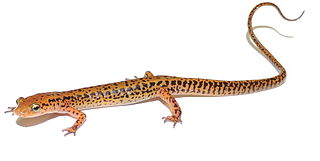
Eurycea longicauda, commonly known as the long-tailed salamander or longtail salamander, is a species of lungless salamander native to the Appalachian Region of the eastern United States. It is a "cave salamander" that frequents twilight zones of caves and also inhabits springs and surrounding forest.
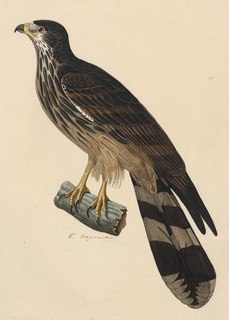
The long-tailed honey buzzard is a bird of prey in the family Accipitridae.

The hooded cuckooshrike is a species of bird in the family Campephagidae. It is found in the New Guinea Highlands.
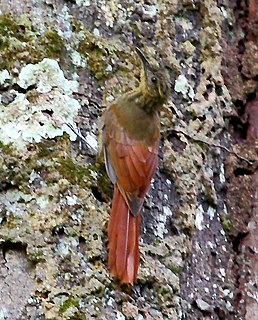
The long-tailed woodcreeper is a species of bird in the Dendrocolaptinae subfamily. It is monotypic within Deconychura, but formerly this genus also included the spot-throated woodcreeper.

The African blue flycatcher or blue-crested flycatcher is a species of bird in the family Stenostiridae from western and central Sub-Saharan Africa.

The serra finch, also known as the pale-throated Pampa-finch, is a species of bird traditionally placed in the family Emberizidae, though recent research suggests it is either very close to the Thraupidae or even part thereof. It is endemic to Brazil. Its natural habitats are dry savanna and subtropical or tropical high-altitude shrubland. It is becoming rare due to habitat loss.

The mid-mountain berrypecker or lemon-breasted berrypecker is a species of bird in the family Melanocharitidae. It is found in Indonesia and Papua New Guinea. Its natural habitats are subtropical or tropical moist lowland forest and subtropical or tropical moist montane forest.

The stripe-chested antwren is a species of bird in the family Thamnophilidae found in Bolivia, Ecuador, and Peru and southwestern Colombia. Its natural habitats are subtropical or tropical moist lowland forests, subtropical or tropical moist montane forests, and heavily degraded former forest.

The striped bandicoot is a species of marsupial in the family Peramelidae. It is found in West Papua, Indonesia and Papua New Guinea. Its natural habitat is subtropical or tropical dry forests. The Striped bandicoot is a host of the Acanthocephalan intestinal parasite Australiformis semoni.
The slimtail skate is a species of fish in the family Arhynchobatidae. It is found in Chile and Peru in its natural habitat of open seas.
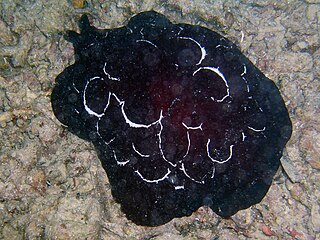
Pleurobranchus forskalii is a species of side-gill sea slug, a notaspidean, a marine gastropod mollusk in the family Pleurobranchidae.
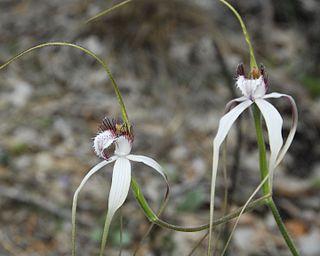
Caladenia longicauda is a species of plant in the orchid family Orchidaceae and is endemic to the south-west of Western Australia. It is distinguished by its large leaf and by its up to five large, white flowers which have drooping sepals and petals with long, thickish brown "tails".
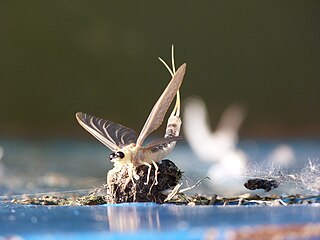
Palingenia longicauda is an aquatic insect in the order Ephemeroptera. It is known as the Tisa or Tisza mayfly after the European Tisza river where it is found and also as the long-tailed mayfly and giant mayfly since it is the largest mayfly species in Europe, measuring 12 cm (4.7 in) from head to tail.

Psychropotes longicauda is a species of sea cucumber in the family Psychropotidae. It inhabits the deep sea where the adult is found on the seabed. The larva is pelagic and has an appendage shaped like a sail on its back which may enable it to move through the water.
Ixorheorida is an order within the subclass Conoidasida of the phylum Apicomplexia. All members of this order are parasitic protozoa.
Ixorheis is a genus of parasitic alveolates in the phylum Apicomplexa.

Stylocheilus striatus is a species of sea hare found in the Indo-pacific region living from the intertidal zone to a depth of 30 metres. Common names include lined sea hare, blue ring sea hare and furry sea hare. Mature animals can reach sizes of up to 65 mm in length and are brown in colour with blue spots. Their diet mainly consists of blue algae. They play an important role in controlling toxic blooms of the cyanobacterium Lyngbya majuscula.
















